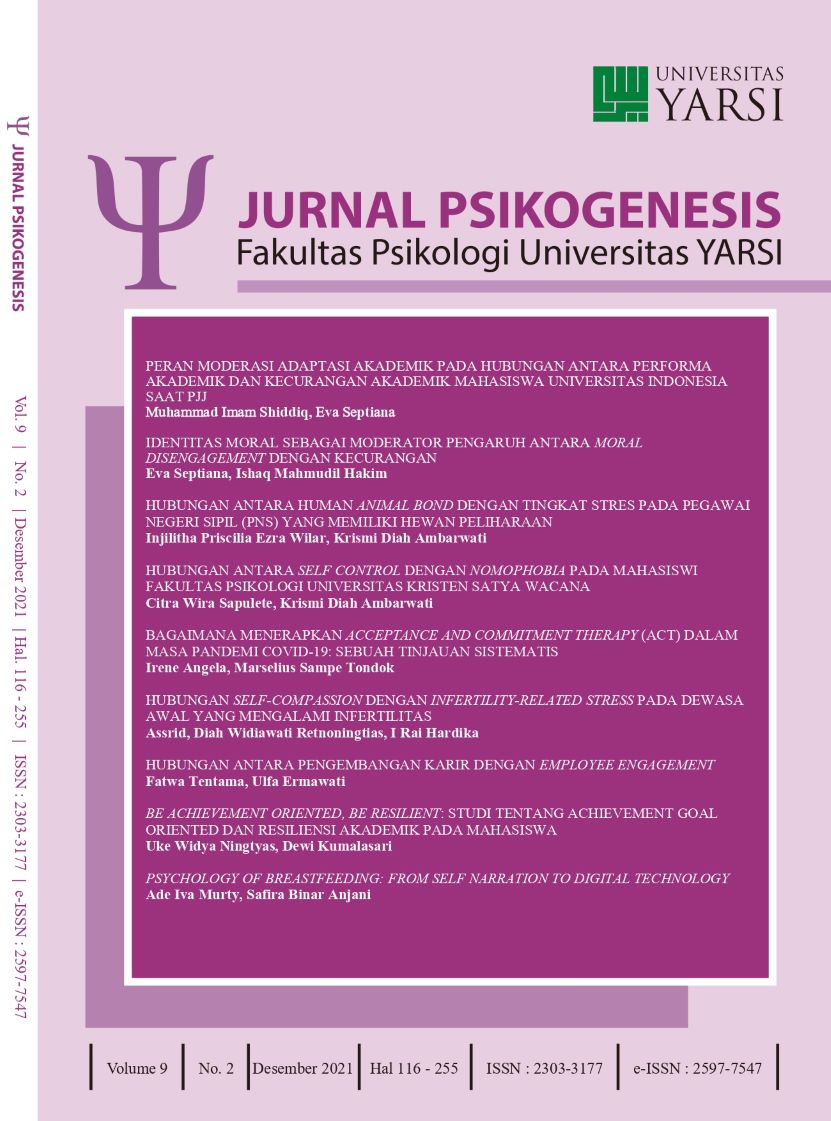Hubungan Antara Self Control Dengan Nomophobia pada Mahasiswi Fakultas Psikologi Universitas Kristen Satya Wacana
Kata Kunci:
Self control, Nomophobia, Mahasiswi Fakultas Psikologi, Universitas Kristen Satya WacanaAbstrak
Penelitian ini merupakan penelitian kuantitatif dengan jenis penelitian korelasional. Tujuan dari penelitian adalah untuk melihat hubungan antara self control dengan nomophobia pada mahasisiwi Fakultas Psikologi Universitas Kristen Satya Wacana. Adapun hipotesis penelitian yang diajukan dalam penelitian ini, yakni ada hubungan yang negatif dan signifikan antara self control dengan nomophobia pada mahasiswi Universitas Kristen Satya Wacana. Total partisipan dalam penelitian ini sebanyak 213 mahasisiwi dengan menggunakan teknik sampling purposive. Pengumpulan data dilakukan dengan cara penyebaran kuesioner secara online melalui google form. Terdapat dua alat ukur yang digunakan dalam penelitian ini, yaitu Self Control Scale (SCS) yang dibuat oleh Tangney, Baumeister & Boone (2004) dengan skor reliabilitas sebesar 0,839. Selain itu ada Nomophobia Questionnaire (NMP-Q) yang dibuat oleh Yildirim (2014) dengan skor reliabilitas sebesar 0,924. Hasil yang diperoleh dari penelitian ini adalah terdapat hubungan negatif dan signifikan antara self control dan nomophobia (rxy= -0,372; 0,00 p<0,05). Dengan demikian, bahwa hipotesis dalam penelitian ini diterima..Referensi
Agusta, D. (2016). Faktor-faktor resiko kecanduan menggunakan smartphone pada siswa di SMK Negeri 1 Kalasan Yogyakarta. E-Journal Bimbingan dan Konseling, 3(5), 86-96. Diperoleh dari http://journal.student.uny.ac.id/ojs/index.php/fipbk/article/view/1021
Aldianita, N., & Maryatmi, A. S. (2019). Hubungan kontrol diri dan perilaku impulsif dengan nomophobia pada remaja pengguna instagram di kelas XI IPS SMAN 31 Jakarta Timur. Jurnak IKRA-ITH Humaniora, 3(3), 118-196. Diperoleh dar https://journals.upi- yai.ac.id/index.php/ikraith-humaniora/article/view/690
Arisandy, D., & Hurriyati, D. (2017). Hubungan antara kontrol diri dengan impulsive buying pada mahasiswi Fakultas Psikologi di Perguruan Tinggi Wilayah Palembang yang melakukan belanja online. Journal Prosiding SNaPP: Kesehatan (Kedokteran, Kebidanan, Keperawatan, Farmasi, Psikologi), 3(1), 31-39. Diperoleh dari http://proceeding.unisba.ac.id/index.php/kesehatan/article/view/1000
Asih, A. T., & fauziah, N. (2017). Hubungan antara kontrol diri dengan kecemasan jauh dari smartphone (nomophobia) pada mahasiswa Jurusan Ilmu Komunikasi Fakultas Ilmu Sosoial dan Politik Universitas Diponegoro Semarang. Jurnal Empati, 6(2), 15-20. Diperoleh dari https://ejournal3.undip.ac.id/index.php/empati/article/view/19725
Asosiasi Penyelenggara Jasa Internet Indonesia. (2019). Responden survei nasional penetrasi pengguna Internet 2018. Jakarta: Asosiasi Penyelenggara jasa Internet Indonesia. Diperoleh dari https://www.apjii.or.id/survei
Azwar, S. (2017). Metode Penelitian Psikologi (2nd ed.) Yogyakarta: pustaka belajar.
Baihagi, A. (2015, Juli 09). Solopos.com: 69% remaja Indonesia pilih main ketimbang nonton TV. Dipeoleh dari https://www.solopos.com/69-remaja-indonesia-pilih-main- ponsel-ketimbang-nonton-tv-622361
Bragazzi, N. L., & Del Puente, G. (2014). A proposal for including nomophobia in the new DSM-V. Psychology Research and Behavior Management, 7, 155-160. https://doi.org/10.2147/PRBM.S41386
Cha, S-S & Seo, B-K. (2018). Smartphone use and smartphone addiction in middle school students in Korea: prevalence, social networking service, and game use. Health Psychology Open, 5(1), 1-15. https://doi.org/10.1177/2055102918755046
Choliz, M. (2012). Mobile-phone addiction in adolescence: The Test of Mobile Phone Dependence (TMD). Progress in Health Sciences, 2(1), 33-44. Diperoleh dari https://www.researchgate.net/publication/284690452_Mobile-phone_addiction_in_adolescence_The_Test_of_Mobile_Phone_Dependence_TMD
De-Sola Gutiérrez, J., Rodríguez de Fonseca, F., & Rubio, G. (2016). Cell-phone addiction: a riview. Frontiers in Psychiatry, 7, 1-15. https://doi.org/10.3389/fpsyt.2016.00175
Geser, H. (2006). Are girl (even) more addicted? Some gender patterns of cell phone usage. Zürich: UniversitätZürich, Philosophische Fakultät, Soziologisches Institut. https://nbn- resolving.org/urn:nbn:de:0168-ssoar-327002
Gezgin, D. M., & Cakir, O. (2016). Analysis of nomophobic behaviors of adolescents regarding various factors. Journal of Human Sciences, 13(2), 2504-2519. https://doi.org/10.14687/jhs.v13i2.3797
Kalaskar, P.B. (2015). A study of awareness of development of nomophobia condition in smartphone user Management Students in Pune city. ASM’s International E-Journal on Ongoing Research in Management and IT, 10, 320-326
Kaplan, R.M dan Saccuzzo, D.P. 2005. Psychological Testing Principles, Application and Issue (6th ed). USA: Wadsworth
Kendall, J. J, 1998, Internet Addiction On Campus: The Vulnerability of College Students, Cyberpsychology & Behavior, 1(1), 11-16. https://doi.org/10.1089/cpb.1998.1.11
Lee, S., Kim, M., Mendoza, J.S., & McDonough, I.M. (2018). Addicted to cellphones: Exploring the psychometric properties between the nomophobia questionnaire and obsessiveness in college students. Heliyon, 4(11), 1–20. https://doi.org/10.1016/j.heliyon.2018.e00895
Lee, S. Y. (2014). Examining the factors that influence early adopters’ smartphone adoption: The case of college students. Telematics and Informatics, 31(2), 308-318. https://doi.org/0.1016/j.tele.2013.06.001
Marsela, R. D., & Supriatna, M. (2019). Kontrol diri: definisi dan faktor. Journal of Innovative Counseling: Theory, Practice & Research, 3(2), 65–69. https://journal.umtas.ac.id/index.php/innovative_counseling
Ozdemir, B., Cakir, O., & Hussain, I. (2018). Prevalence of nomophobia among university students: a comparative study of Pakistani and Turkish undergraduate students. Eurasia Journal of Mathematics, Science and Technology Education, 14(4), 1519–1532. https://doi.org/10.29333/ejmste/84839
Park, N., & Lee, H. (2014). Nature of youth smarthpone sddiction in Korea. Theory Information Research, 51(1), 100-132. http://icr.snu.ac.kr/jcr
Prasetyo, A., & Ariana, A, D. (2016). Hubungan antara The Big Five Personality dengan Nomophobia pada Wanita Dewasa Awal. Jurnal psikologi klinis dan kesehatan mental, 5(1), 1-9. Diperoleh dari http://journal.unair.ac.id/JPKK@-the-relationship-between-the-big-five-personality-and-nomophobia-on-young-adult-women-article-10577-media-51-category-10.html
Rudiyana. (2012). Dampak Penggunaan Smartphone pada Perilaku Remaja di SMA Kesatuan 1 Samarinda. Jurnal Ilmu Komunikasi Fisip Univeristas Mulawarman, 2, 181- 190.
Santos, T., Da Silva, L.K., Abbas, W., De Souza, L.A., & De Sá, L.V. (2017). Cade meu celular? Uma análise da nomofobia no ambiente organizacional. RAE- Revista de Administração de Empresas, 57(6), 634–635. http://dx.doi.org/10.1590/S0034-759020170611
Securenvoy. (2012, Februari 16). Securenvoy: 66% of the population suffer from Nomophobia the fear of being without their phone. Diperoleh dari https://www.securenvoy.com/en-gb/blog/66-population-suffer-nomophobia-fear-being-without-their-phone
Smahel, D., Brown, B. B., & Blinka, L. (2012). Associations between Online Friendship and Internet Addiction among Adolescents and Emerging Adults, Developmental Psychology, 48 (2), 381-288. https://doi.org/10.1037/a0027025
Sugiyono. (2010). Metode Penelitian Pendidikan Pendekatan Kuantitatif, kualitatif, dan R&D. Bandung: Alfabeta.
Sugiyono. (2019). Statistika untuk penelitian. Bandung: Penerbit Alfabeta.
Tangney, J.P., Baumeister, R. F., & Boone, A. L. (2004). High Self-Control Predicts Good Adjustment, Less Pathology, Better Grades, and Interpersonal Success. Journal of personality, 72(2), 271-324. https://doi.org/10.1111/j.0022-3506.2004.00263.x
Tomat Digital Indonesia. (2019, Februari 08). Tomat Digital Indonesia: Data Digital Indonesia 2019: Sebuah Pengantar Awal Tahun. Diperoleh dari https://www.tomato.co.id/data-digital-indonesia-2019/
Yaldirim, C. (2014). Exploring the dimensions of nomophobia: Developing and validating a questionnaire using mixed methods research (Graduate Theses and Dissertations, Iowa State University, 2014). Diperoleh dari https://lib.dr.iastate.edu/cgi/viewcontent.cgi?article=5012&context=etd
Zhety, C., & Octaviani, E. F. (2017). Nomophobia around us!. Journal of innovative research in social sciences & humanities, 1(1), 16-20. Diperoleh dari http://ijirhsc.com/wp- content/uploads/2017/06/FOUR-SCH.pdf
Unduhan
Diterbitkan
Cara Mengutip
Terbitan
Bagian
Lisensi
Authors who publish with this journal agree to the following terms:- Authors retain copyright and grant the journal right of first publication with the work simultaneously licensed under a Creative Commons Attribution License that allows others to share the work with an acknowledgement of the work's authorship and initial publication in this journal.
- Authors are able to enter into separate, additional contractual arrangements for the non-exclusive distribution of the journal's published version of the work (e.g., post it to an institutional repository or publish it in a book), with an acknowledgement of its initial publication in this journal.
- Authors are permitted and encouraged to post their work online (e.g., in institutional repositories or on their website) prior to and during the submission process, as it can lead to productive exchanges, as well as earlier and greater citation of published work (See The Effect of Open Access).

 Citra Wira Sapulete
Citra Wira Sapulete
 Universitas Kristen Satya Wacana
Universitas Kristen Satya Wacana










